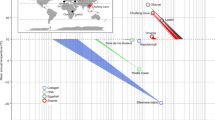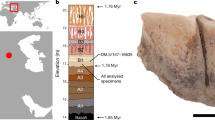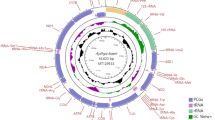Abstract
One of the great enigmas of mammalian phylogeny is the genealogical relationship of the aardvark (Orycteropus afer), the only living representative of the order Tubulidentata. Although now generally grouped close to the ungulates and paenungulates1–4, and thought to be derived from a common condylarthran stock5–7, it still holds an isolated position among eutherian mammals. The evidence of the evolutionary relationships of the aardvark may be obscured at the morphological and anatomical level by the pronounced adaptations to its ant-eating and burrowing habits, and may be better preserved in its protein molecules, as direct copies of the genetic material. We have therefore now studied the amino acid sequence of the eye lens protein α-crystallin A of the aardvark, and compared it with the corresponding sequences from species representing 15 mammalian orders. Unique similarities were observed among the α-crystallin A sequences of aardvark and the paenungulates manatee, hyrax and elephant, suggesting that the closest relatives of the Tubulidentata are found in the paenungulate orders Sirenia (sea cows), Hydracoidea (hydraxes) and Proboscidea (elephants). Moreover, these orders do not seem to be derived from a common stem group with the ungulates, but might well be one of the first offshoots of the placental mammalian line.
This is a preview of subscription content, access via your institution
Access options
Subscribe to this journal
Receive 51 print issues and online access
$199.00 per year
only $3.90 per issue
Buy this article
- Purchase on Springer Link
- Instant access to full article PDF
Prices may be subject to local taxes which are calculated during checkout
Similar content being viewed by others
References
Simpson, G. G. Bull. Am. Mus. nat. Hist. 85, 1–350 (1945).
Van Valen, L. Evolution 25, 420–428 (1971).
McKenna, M. C. in Phytogeny of the Primates (eds Luckett, W. P. & Szalay, F. S.) 21–46 (Plenum, New York, 1975).
Szalay, F. S. in Major Patterns in Vertebrate Evolution (eds Hecht, M. K., Goody, P. C. & Hecht, B. M.) 315–374 (NATO Advanced Study Institute, Plenum, New York, 1977).
Romer, A. S. Vertebrate Paleontology 3rd edn (University of Chicago Press, 1966).
Thenius, E. Phylogenie der Mammalia (de Gruyter, Berlin, 1969).
Patterson, B. in Evolution of African Mammals (eds Maglio, V. J. & Cooke, H. B. S.) 268–278 (Harvard University Press, 1978).
Bloemendal, H. (ed.) Molecular and Cellular Biology of the Eye Lens (Wiley-Interscience, New York, 1981).
Clayton, R. M. in The Eye Vol. 5 (ed. Davson, H.) 399–494 (Academic, New York, 1974).
De Jong, W. W., Gleaves, J. T. & Boulter, D. J. molec. Evol. 10, 123–135 (1977).
De Jong, W. W., Zweers, A., Joysey, K. A., Gleaves, J. T. & Boulter, D. in The Evolution and Ecology of Sloths, Anteaters and Armadillos (ed. Montgomery, G. G.) (Smithsonian Institution Press, Washington DC, in the press).
Moore, G. W., Barnabas, J. & Goodman, M. J. theor. Biol. 38, 459–485 (1973).
Moore, G. W. in Molecular Anthropology (eds Goodman, M. & Tashian, R. E.) 117–137 (Plenum, New York, 1976).
Shoshani, J., Goodman, M. & Prychodko, W. Am. Zool. 18, 601 (1978).
Le Gros Clark, W. E. & Sonntag, D. F. Proc. zool. Soc. Lond. 30, 445–485 (1926).
Engelmann, G. F. in The Evolution and Ecology of Sloths, Anteaters and Armadillos (ed. Montgomery, G. G.) (Smithsonian Institution Press, Washington DC, in the press).
Dene, H., Goodman, M. & Romero-Herrera, A. E. Proc. R. Soc. B207, 111–127 (1980).
Van der Ouderaa, F. J., De Jong, W. W. & Bloemendal, H. Eur. J. Biochem. 39, 207–222 (1973).
De Jong, W. W. & Terwindt, E. C. Eur. J. Biochem. 67, 503–510 (1976).
Van Druten, J. A. M., Peer, P. G. M., Bos, A. B. H. & De Jong, W. W. J. theor. Biol. 73, 549–561 (1978).
Author information
Authors and Affiliations
Rights and permissions
About this article
Cite this article
de Jong, W., Zweers, A. & Goodman, M. Relationship of aardvark to elephants, hyraxes and sea cows from α-crystallin sequences. Nature 292, 538–540 (1981). https://doi.org/10.1038/292538a0
Received:
Accepted:
Issue Date:
DOI: https://doi.org/10.1038/292538a0
This article is cited by
-
The insular cortex: a comparative perspective
Brain Structure and Function (2010)
-
Divergence time estimates of mammals from molecular clocks and fossils: Relevance of new fossil finds from India
Journal of Biosciences (2009)
-
Genome Size: A Novel Genomic Signature in Support of Afrotheria
Journal of Molecular Evolution (2007)
-
The necessity of functional proteomics: protein species and molecular function elucidation exemplified by in vivo alpha A crystallin N-terminal truncation
Amino Acids (2006)
-
Endemic African mammals shake the phylogenetic tree
Nature (1997)
Comments
By submitting a comment you agree to abide by our Terms and Community Guidelines. If you find something abusive or that does not comply with our terms or guidelines please flag it as inappropriate.



